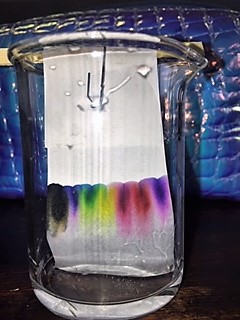Chromatography





Chromatography is a laboratory technique for the separation of a mixture. The mixture is dissolved in a fluid called the mobile phase, which carries it through a structure holding another material called the stationary phase. The various constituents of the mixture travel at different speeds, causing them to separate. The separation is based on differential partitioning between the mobile and stationary phases. Subtle differences in a compound's partition coefficient result in differential retention on the stationary phase and thus affect the separation.
Chromatography may be preparative or analytical. The purpose of preparative chromatography is to separate the components of a mixture for more advanced use (and is thus a form of purification). Analytical chromatography is done normally with smaller amounts of material and is for establishing the presence or measuring the relative proportions of analytes in a mixture.
Types of Chromatography[edit]
Chromatography techniques can be classified by the mechanism of separation. The most common types include:
- Gas Chromatography (GC) - where the mobile phase is a gas and the stationary phase is a liquid or solid.
- High-Performance Liquid Chromatography (HPLC) - uses high pressure to push a liquid mobile phase through a stationary phase.
- Thin Layer Chromatography (TLC) - where the stationary phase is a thin layer of adsorbent material on a glass, metal, or plastic plate.
- Paper Chromatography - uses paper as the stationary phase.
- Ion Exchange Chromatography - separates ions and polar molecules based on their affinity to the ion exchanger.
- Size Exclusion Chromatography (SEC) - also known as gel filtration chromatography, separates molecules based on their size.
- Affinity Chromatography - is based on selective non-covalent interaction between an analyte and specific molecules. It is often used in biochemistry in the purification of proteins bound to tags.
Applications[edit]
Chromatography is used in both qualitative and quantitative analysis of both organic and inorganic samples. It has a wide range of applications:
- In the pharmaceutical industry, chromatography is used to prepare large quantities of extremely pure materials.
- In environmental monitoring, it is used to detect pollutants in air and water.
- Chromatography techniques are essential in the field of biochemistry for separating and analyzing complex protein mixtures.
- In the food industry, it is used for analyzing food products for quality control and to ensure compliance with food safety standards.
- Forensic science utilizes chromatography for analyzing drugs, blood samples, and fibers.
Chromatography Theory[edit]
The theory of chromatography revolves around the concept of separation. Separation occurs due to the different speeds at which the components of a mixture move through the stationary phase, depending on their interactions with the mobile and stationary phases. The efficiency of a chromatographic separation is measured by the resolution between two peaks in a chromatogram, which depends on the column length, the nature of the stationary phase, the temperature, and the flow rate of the mobile phase.
See Also[edit]
Ad. Transform your life with W8MD's Budget GLP-1 injections from $75


W8MD offers a medical weight loss program to lose weight in Philadelphia. Our physician-supervised medical weight loss provides:
- Weight loss injections in NYC (generic and brand names):
- Zepbound / Mounjaro, Wegovy / Ozempic, Saxenda
- Most insurances accepted or discounted self-pay rates. We will obtain insurance prior authorizations if needed.
- Generic GLP1 weight loss injections from $75 for the starting dose.
- Also offer prescription weight loss medications including Phentermine, Qsymia, Diethylpropion, Contrave etc.
NYC weight loss doctor appointmentsNYC weight loss doctor appointments
Start your NYC weight loss journey today at our NYC medical weight loss and Philadelphia medical weight loss clinics.
- Call 718-946-5500 to lose weight in NYC or for medical weight loss in Philadelphia 215-676-2334.
- Tags:NYC medical weight loss, Philadelphia lose weight Zepbound NYC, Budget GLP1 weight loss injections, Wegovy Philadelphia, Wegovy NYC, Philadelphia medical weight loss, Brookly weight loss and Wegovy NYC
|
WikiMD's Wellness Encyclopedia |
| Let Food Be Thy Medicine Medicine Thy Food - Hippocrates |
Medical Disclaimer: WikiMD is not a substitute for professional medical advice. The information on WikiMD is provided as an information resource only, may be incorrect, outdated or misleading, and is not to be used or relied on for any diagnostic or treatment purposes. Please consult your health care provider before making any healthcare decisions or for guidance about a specific medical condition. WikiMD expressly disclaims responsibility, and shall have no liability, for any damages, loss, injury, or liability whatsoever suffered as a result of your reliance on the information contained in this site. By visiting this site you agree to the foregoing terms and conditions, which may from time to time be changed or supplemented by WikiMD. If you do not agree to the foregoing terms and conditions, you should not enter or use this site. See full disclaimer.
Credits:Most images are courtesy of Wikimedia commons, and templates, categories Wikipedia, licensed under CC BY SA or similar.
Translate this page: - East Asian
中文,
日本,
한국어,
South Asian
हिन्दी,
தமிழ்,
తెలుగు,
Urdu,
ಕನ್ನಡ,
Southeast Asian
Indonesian,
Vietnamese,
Thai,
မြန်မာဘာသာ,
বাংলা
European
español,
Deutsch,
français,
Greek,
português do Brasil,
polski,
română,
русский,
Nederlands,
norsk,
svenska,
suomi,
Italian
Middle Eastern & African
عربى,
Turkish,
Persian,
Hebrew,
Afrikaans,
isiZulu,
Kiswahili,
Other
Bulgarian,
Hungarian,
Czech,
Swedish,
മലയാളം,
मराठी,
ਪੰਜਾਬੀ,
ગુજરાતી,
Portuguese,
Ukrainian
